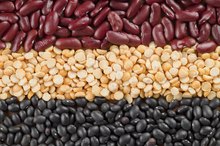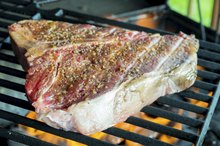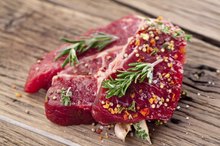Amino Acids in Fish, Poultry and Beef
Amino acids are the building blocks of protein, which your body uses to make new tissues and repair damaged tissues, and protein-rich foods like fish, poultry and beef are some of the best sources. The amino acid profiles of animal foods vary, with some being higher in certain amino acids than others. However, eating a varied diet that includes poultry, fish and beef, as well as other animal and plant foods, ensures you get all the amino acids your body needs.
Types of Amino Acids
There are hundreds of amino acids that occur in nature, but only 21 of them are used for protein synthesis. Amino acids are generally divided into three categories: essential, nonessential and conditional.
Essential amino acids -- nine of the amino acids you use to make protein -- are the ones your body can't make, so you need to get from food. Nonessential amino acids are the ones your body makes on its own, so it's not necessary to get them from food. However, during times of illness or stress, your body may not be able to produce everything it needs, at which point you will need to get them from food. These are called conditional amino acids.
Fish, poultry and beef provide all the essential amino acids, which makes them complete proteins. They also contain all the conditional amino acids
How Much You Need
How Much Protein Is in a Filet of Flounder?
Learn More
The Institute of Medicine provides recommendations for the nine essential amino acids based on milligrams per grams of protein. For example, the recommended intake of histidine is 18 milligrams per gram of protein, and the recommendation for lysine is 51 milligrams per gram of protein. The daily recommended intake of protein for men is 56 per day; for women, it's 46 grams per day.
That means a man would need 1,000 milligrams of histidine per day and 2,856 milligrams of lysine per day, while a woman would need 828 milligrams of histidine and 2,346 milligrams of lysine. The recommended intake of tryptophan is 7 milligrams per gram of protein, meaning men need 392 milligrams per day and women need 322 milligrams daily.
Sample Amounts
Three ounces of chicken, salmon or ground beef provides between 575 and 765 milligrams of histidine, 1,500 to 2,100 milligrams of lysine and 90 to 290 milligrams of tryptophan. Chicken is the richest source of the three amino acids, then salmon, then ground beef. Three ounces of turkey, trout or top sirloin steak provides 575 to 829 milligrams of histidine, 1,790 to 2,195 milligrams of lysine and 170 to 265 milligrams of tryptophan. Top sirloin is the richest source of histidine and lysine and the lowest in tryptophan. Turkey is most abundant in tryptophan among the three protein sources.
Getting What You Need
How to Mix Tuna With Egg Whites
Learn More
Unless your doctor has advised you to track your intake of a specific amino acid for a particular health reason, there's no need to worry about the amounts of each amino acid in fish, poultry and beef. The most important thing is getting enough protein and making sure that you get enough complete protein. Three ounces of salmon, chicken or beef provides between 18 and 25 grams of complete protein. Just two to four servings daily is enough for most adults to meet their protein needs and their essential amino acid needs.
Related Articles
References
Writer Bio
Jody Braverman is a professional writer and editor based in Atlanta. She studied creative writing at the American University of Paris and received a Bachelor of Arts in English from the University of Maryland. She also received personal trainer certification from NASM and her 200-hour yoga teacher certification from YogaWorks.









